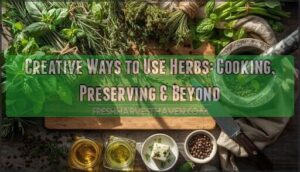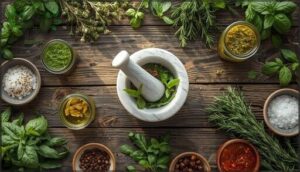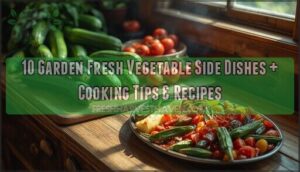This site is supported by our readers. We may earn a commission, at no cost to you, if you purchase through links.
Your spice cabinet probably holds more potential than you realize. Those bunches of fresh herbs you buy for one recipe don’t have to wilt forgotten in the crisper drawer. From transforming plain water into a revitalizing antioxidant boost to whipping up compound butters that’ll make restaurant chefs jealous, herbs can transform your cooking without fancy techniques or equipment.
They’re the secret ingredient that turns everyday meals into something memorable—and they offer health perks that go way beyond flavor.
Whether you’re looking to cut back on salt, preserve your farmer’s market haul, or finally use that overgrown basil plant, you’ll find practical ways to make herbs work harder in your kitchen and beyond.
Table Of Contents
Key Takeaways
- Fresh herbs elevate everyday cooking through simple techniques like infusing water for antioxidant benefits, making compound butters that freeze for six months, and adding them to grains and risottos at the last minute to preserve essential oils and cut sodium by 30%.
- Homemade herb-based sauces, seasonings, and condiments—from chimichurri variations to herb salts at 4:1 ratios—deliver bigger flavor and health benefits than store-bought versions while letting you control sodium levels and explore creative flavor combinations beyond traditional recipes.
- Proper preservation methods like freezing herbs in olive oil cubes, air-drying to below 12% moisture, or storing fresh bunches in water-filled jars can extend shelf life from days to six months, eliminating waste and keeping garden-fresh flavor ready whenever you need it.
- Herbs work beyond the kitchen as natural cleaning solutions with antibacterial properties, DIY skincare ingredients, eco-friendly air fresheners, and craft materials that replace synthetic products while supporting soil health and pest control in home gardens.
Creative Herb Uses in Everyday Cooking
Herbs have a way of turning everyday meals into something special without much effort. You don’t need fancy techniques or a culinary degree to realize their potential.
Let’s explore some simple ways to weave fresh herbs into your daily cooking routine.
Infusing Water and Beverages With Fresh Herbs
With a handful of mint or basil, you can turn plain water into HerbInfused Water bursting with Antioxidant benefits and flavor. Herbal Infusions aren’t just tasty—they support Weight management and offer Functional properties like calming and digestive perks. The market is seeing growth due to increasing health demands.
For top results:
- Use fresh herbs for Sensory acceptance.
- Chill for best taste.
- Guarantee Microbial safety with clean prep.
Enhancing Salads and Dressings With Herbs
Fresh herbs transform ordinary salads into something memorable. Toss basil with cheese or pair cilantro with avocado—these herb flavor pairings make your salad recipes shine. Add parsley, dill, or mint just before serving to lock in that bright taste.
Fresh herbs such as basil, cilantro, and chives are popular choices for adding flavor.
Homemade salad dressings with herbs beat store-bought versions every time, delivering sensory salad benefits and nutritional herb impact without the sodium overload.
Making Herb Butters and Oils for Cooking
You can take flavor enhancement to the next level by blending minced herbs with softened butter—add 2 to 4 tablespoons per stick for ideal flavor combinations. Herb butter freezes beautifully for up to six months.
Herb oil offers similar culinary uses when you blend olive oil with garlic and fresh herbs, though safety concerns require refrigeration and using it within four days.
Incorporating Herbs Into Soups, Grains, and Risottos
While herb butters and oils add richness, stirring fresh herbs into grains and risottos brings them to life. You’ll discover wonderful herb flavor pairings when you add mixed greens during the last five minutes—this preserves those essential oils. Try these salt reduction strategies:
- Toss parsley, chives, or basil into risotto for vitamin K and iron
- Boost soup herb diversity with oregano, thyme, and sage combinations
- Experience grain herb benefits by adding herbs post-cooking
- Watch how herb-rich soups naturally decrease your need for extra salt
Risotto herb timing matters—late additions keep flavors bright.
Baking Savory Breads and Pastries With Herbs
Beyond risotto, you’ll find exceptional creative baking with herbs in savory dishes—rosemary focaccia and cheese twists are flavorful breakfast ideas.
Dried herbs deliver concentrated herb flavor profiles requiring only one-third the fresh amount. Dough hydration impacts texture, so adjust water when adding fresh greens.
You’ll gain nutritional herb benefits like antioxidants, plus shelf life extension up to 30%. Recipe trend analysis shows herbed breads are skyrocketing in popularity, making these baking ingredients essential for modern savory dishes.
Unique Sauces, Condiments, and Seasonings
Homemade herb sauces and seasonings can transform even the simplest dishes into something memorable. You don’t need fancy ingredients or complicated techniques—just fresh herbs and a little creativity.
Here’s how to build a collection of flavorful condiments that’ll make everything you cook taste better.
Crafting Chimichurri and Pesto With Varied Herbs
You can turn your favorite green sauce into a fresh-herb adventure by stepping away from the usual parsley-and-basil routine. Contemporary herb sauce trends show that chimichurri and pesto are more adaptable than you might think, opening doors to bold regional pesto variations and new chimichurri flavor profiles:
- Swap parsley for cilantro in chimichurri to create a Latin-fusion twist that’s bright and zippy.
- Try Thai basil with pistachios for pesto that breaks the mold while keeping that rich, nutty backbone.
- Mix mint or dill into your chimichurri for unexpected freshness that wakes up grilled meats.
- Use arugula in place of basil for a peppery pesto that adds personality to pasta and sandwiches.
- Remember food safety risks: refrigerate herb-and-garlic oils promptly and use them within a few days to avoid botulism concerns.
These adaptable herb sauces deliver herb nutritional benefits—antioxidants, flavor without sodium—while letting you explore what fresh herbs can really do beyond the expected.
Blending Homemade Herb Salts and Seasoning Mixes
With just a handful of ingredients, you can create homemade herb salts that outshine store-bought seasoning mixes—and they’re healthier too. Start with coarse sea salt and layer in dried rosemary, thyme, or oregano at a 4:1 herb-salt ratio for balanced Salt Flavor Profiles.
Fresh herb salt needs refrigeration and lasts six months in airtight containers—perfect for Culinary Applications like roasted vegetables, grilled meats, and everyday dishes that deserve more personality.
Creating Herb-infused Vinegars and Oils
You can transform plain vinegar and olive oil into bold flavor powerhouses with just a few sprigs of fresh herbs.
For safe, delicious herbal infusions, use Ideal Ratios of 12–16 oz vinegar to 1–2 handfuls of herbs, letting them steep at least 24 hours.
DIY Herb-Infused Oils require dried herbs or refrigeration within 2–4 days for Infusion Safety—preventing botulism while creating stunning Flavor Combinations for everyday Culinary Applications.
Making Herb-forward Salsas and Dips
Fresh herbs can boost your salsas and dips with vibrant flavor and serious health benefits—think antioxidants, fiber, and potassium that support your heart and gut. The market agrees: herby, fresh-flavored vegan options surged over 15% globally since 2022, driven by consumer trends toward clean-label ingredients.
Try these flavorful sauce recipes with smart herb ratios:
- Classic cilantro salsa: 0.25 cups cilantro per 3 cups tomatoes
- Herb chimichurri with parsley, oregano, and garlic
- Gremolata with lemon zest and fresh parsley
- HerbOlive salsa blending basil and green olives
- Creamy avocado-dill dip for adaptable herb sauces
These recipes deliver big flavor without overwhelming sodium—commercial versions can hit 742 mg per 100 grams, so homemade gives you control.
Healthy and Flavorful Herb-Infused Recipes
Fresh herbs don’t just add flavor—they transform everyday meals into something memorable. A handful of chopped basil or a sprinkle of fresh thyme can turn a simple dinner into a restaurant-worthy dish without any extra effort.
Fresh herbs transform everyday meals into something memorable with minimal effort and maximum flavor
Let’s explore some easy, herb-packed recipes that’ll make your kitchen smell wonderful and your taste buds happy.
Quick Dinner Ideas Using Fresh Herbs
You don’t need hours to make dinner taste delightful—fresh herbs are your shortcut. In under 25 minutes, you can plate dishes like Thai basil eggplant or tortellini with avocado pesto. Adding herbs at the last minute locks in flavor while cutting sodium by 30%.
Here’s how herb prep time and flavor pairings deliver nutrient boost and recipe versatility:
| Quick Dinner Ideas | Herb + Prep Time |
|---|---|
| Strawberry basil bruschetta | Basil, 10 min |
| Lemon herb quinoa | Parsley/cilantro, 15 min |
| Roasted beets with herbed yogurt | Dill, 20 min |
These easy recipes prove flavorful dishes don’t require fancy skills—just fresh herbs and smart timing.
Vegetarian and Mediterranean-inspired Dishes
Mediterranean cuisine brings vegetarian recipes to life with fresh herbs like oregano, basil, and rosemary—featured in over 80% of traditional dishes. These culinary techniques deliver nutritional benefits and health outcomes you can taste.
Try these flavor combinations:
- Za’atar-roasted chickpeas with lemon and parsley
- Herb-forward Greek salad with fennel and dill
- Basil pesto pasta tossed with sun-dried tomatoes
- Rosemary white bean stew with thyme
Herb combinations transform simple ingredients into market trend favorites.
Herb-packed Breakfast and Brunch Recipes
Brunch gets a flavorful upgrade when you toss fresh herbs into your morning routine. Herb omelets deliver 19 grams of protein and over 150% of your vitamin K—perfect with parsley or chives.
Savory breads with rosemary boost antioxidants by 14%, while herb yogurt spreads add calcium.
Try potato dishes with thyme or breakfast smoothies spiked with mint for 12–16 mg extra vitamin C.
| Recipe Type | Key Herbs | Top Nutrient Boost |
|---|---|---|
| Herb Omelets | Parsley, Chives | 153% Vitamin K |
| Savory Breads | Rosemary, Thyme | 14% More Antioxidants |
| Breakfast Smoothies | Mint, Basil | 12–16 mg Vitamin C |
Grilled Meats, Fish, and Seafood With Herbal Marinades
Moving from breakfast to backyard, herbal marinades transform your grilled proteins into healthier, more flavorful meals. Wine and vinegar marinades cut harmful compounds by up to 82%, while rosemary and thyme blends slash carcinogens by 40–85%.
Tea-based marinades with fresh herbs drop toxins in grilled chicken by 57%, proving flavor profiles matter for health.
- Marinade safety: Acidic herb blends reduce bacteria and extend shelf life
- Meat quality: Phosphate-free herb mixes improve tenderness and juiciness
- Sustainable grilling: Low-sodium citrus-herb combinations deliver big flavor with minimal environmental impact
Innovative Ways to Preserve and Store Herbs
You’ve probably watched fresh herbs wilt and turn to mush in your fridge more times than you’d like to admit.
The good news is that preserving herbs doesn’t have to be complicated or time-consuming.
Let’s explore some smart methods that’ll keep your herbs flavorful and ready to use for months to come.
Freezing Herbs in Olive Oil or as Cubes
Want your fresh herbs to last months instead of days? Freeze herbs in olive oil cubes for unbeatable flavor retention and freezing safety.
Chop basil, parsley, rosemary, or thyme, pack them into ice cube trays, cover with olive oil, and freeze overnight. Each cube delivers pre-measured portions perfect for soups, sautés, and marinades.
Storage duration? Up to six months of garden-fresh taste, ready when you’re.
Drying and Storing Herbs for Long-term Use
By drying fresh herbs properly, you control moisture levels—ideally below 12%—and lock in flavor for months. Air-dry leafy varieties upside down, or use your oven at low heat for faster results.
Once dried, store them in opaque, airtight containers away from light and heat. These herb preservation methods keep your pantry stocked year-round, meeting the rising demand for natural seasonings in home kitchens everywhere.
Storing Fresh Herbs for Maximum Shelf Life
For fresh herbs, storing them right can stretch freshness from days to weeks. Keep leafy bunches in water-filled jars—like flowers—covered with plastic bags in the fridge. Ideal temperature around 0°C works wonders, while hardy varieties wrapped in damp towels last even longer.
Packaging techniques and water management matter more than you’d think, turning wilted stems into vibrant flavor bombs ready whenever inspiration strikes.
Creating Herbal Teas and Infusions
Beyond the kitchen, transforming fresh herbs into tea blends unlocks serious health benefits—from chamomile’s calming effects to lavender’s stress relief.
Try simple infusion methods: steep delicate leaves 5–15 minutes, or simmer tougher roots for 20.
With herbal tea blends driving 30% year-over-year sales growth and consumption patterns favoring natural remedies, you’re tapping into both ancient wisdom and market trends that actually deliver wellness.
Creative Herbal Uses Beyond The Kitchen
Herbs don’t have to stop working their magic once you leave the kitchen. You can bring their natural benefits into your bathroom, cleaning routine, and even your home décor.
Here are some creative ways to put those extra sprigs to work around your house.
DIY Herbal Bath Soaks and Skincare
You don’t need a spa to unwind—just a handful of dried lavender, chamomile, or calendula mixed with Epsom salt creates luxurious homemade bath soaks that soothe your skin and calm your mind.
DIY skincare with herbs like aloe vera and rose petals offers natural skincare benefits without synthetic chemicals.
Store your herbal bath and body products in airtight jars, and they’ll stay potent for months.
Natural Cleaning Solutions With Antibacterial Herbs
Your kitchen herbs moonlight as powerful natural cleaning solutions. Thyme’s antibacterial activity and oregano as disinfectant can tackle bacteria on counters, while tea tree oil mixed with vinegar creates eco-friendly cleaning sprays.
Rosemary and sage boost antimicrobial power in DIY blends. These herbs for cleaning offer effective, natural cleaning without harsh chemicals, proving herbal home remedies work brilliantly beyond the stove.
Herb-based Air Fresheners and Home Fragrance
Your herbs can transform your home into a fragrant sanctuary with natural air fresheners that outperform synthetic sprays. According to scent preferences, over half of consumers favor herbal-based fragrances for their authenticity and health benefits.
Try these aromatic home décor ideas:
- Simmer rosemary and lavender on the stove for instant home fragrance
- Create herbal sachets with dried mint for sustainable sourcing
- Follow DIY recipes blending eucalyptus oil with water in spray bottles
These market trends reflect growing demand for natural air freshening solutions.
Eco-friendly Crafts and Décor With Dried Herbs
You can turn dried herbs into stunning wreaths, pressed botanical art, and fragrant sachets that replace over 1,000 synthetic air fresheners per household annually. These homemade crafts use eco-friendly materials—think lavender, thyme, and sage—requiring zero post-harvest irrigation while cutting plastic décor by 30%.
The dried herbs market is booming toward $3.88 billion by 2034, proving herb craft sustainability isn’t just beautiful—it’s resource-efficient and kind to your wallet.
Frequently Asked Questions (FAQs)
Can herbs improve soil health in home gardens?
Your herb garden works wonders underground. Root systems break up compacted soil, nutrient cycling feeds the earth, and soil microbes thrive around fresh herbs.
You’ll see better weed suppression and balanced soil pH—plus healthier plants all around.
Which herbs naturally repel garden pests and insects?
Imagine your grandfather’s victory garden, but with a secret weapon. Basil pest control, mint insect repellent, rosemary deterrent uses, and garlic garden shield naturally banish flies, mosquitoes, aphids, and beetles—catnip bug defense even stops squash bugs cold.
Are certain herbs toxic to household pets?
Yes, several herbs pose real dangers to pets. Garlic, onions, oregano, and bay leaf can trigger vomiting or anemia in dogs and cats.
Essential oils from tea tree or eucalyptus are especially risky, causing tremors and weakness.
How do you propagate herbs from cuttings?
You can propagate fresh herbs from your herb garden using water propagation or soil.
Take 10–15 cm cuttings below a leaf node, remove lower leaves, and maintain humidity. Rooting hormones boost cutting success rates considerably.
Can herbs be used in homemade natural dyes?
Herbs like turmeric, madder, and indigo have colored fabrics for centuries.
Modern extraction methods boost pigment yield by 42%, while natural mordants improve color fastness.
These eco-friendly dyes reduce chemical pollution and skin allergies.
Conclusion
Think of herbs as seeds of possibility scattered throughout your kitchen—each one ready to sprout into something unexpected. You’ve just uncovered creative ways to use herbs that reach far beyond the recipe card, from capturing summer’s flavor in a jar to crafting natural remedies that honor ancient wisdom.
Your next meal, your next project, your next experiment starts with whatever’s growing on your windowsill. That’s where transformation begins.
- https://www.nifa.usda.gov/about-nifa/impacts/nifa-funded-researchers-aim-boost-herb-production-controlled-environments
- https://www.grandviewresearch.com/industry-analysis/fresh-herbs-market-report
- https://www.statista.com/outlook/emo/food/sauces-spices/spices-culinary-herbs/worldwide
- https://www.fortunebusinessinsights.com/culinary-herbs-market-111089
- https://www.biospace.com/press-releases/medicinal-herbs-market-to-hit-us-478-93-billion-by-2032-growing-at-11-21-cagr-driven-by-rising-demand-for-natural-remedies-and-product-innovation











